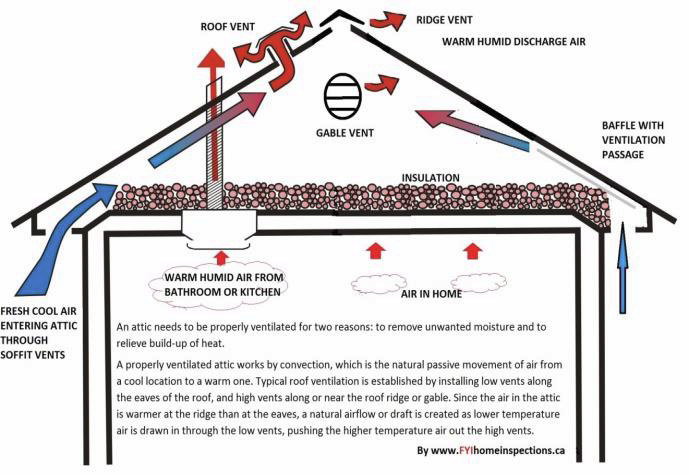Proper attic ventilation is critical to the long-term performance of your roof as well as the attic space directly under it. Have you ever wondered why your attic smells musty? It’s likely due to lack of proper ventilation. A properly ventilated attic can reduce cooling bills, extend shingle life and prevent mold growth, roof rot and ice dams in the winter.
How to determine if you need better attic ventilation
When an attic is properly ventilated it will reduce heat buildup during the summer months. That in turn reduces cooling costs and prolongs shingle life. In the winter, warm moist air seeps into the attic from the living space below. Good ventilation allows the heat and moisture to escape, keeping your attic dry.
Where to place roof vents
For optimum results, place roof vents near the roof’s peak and soffit vents in the eaves. Air flows through the soffit vents and out through the roof vents. Consult with a roofing professional to get the best ventilation solutions for your roof.
Attic ventilation options:
Ridge Vent: This is a ventilation strip that is placed along the ridge line of the home. Prior to installing the ridge vent a 1” wide strip of roof decking is cut out along both sides of the ridge line to allow for air movement through the vent.
Soffit vents/insulation baffles: A critical part of installing any system of ventilation into your roof system is to make sure there is a point of entry and a point of exit for air flow. Review the soffit areas of your home for soffit vents. Soffit vents allow convective air movement from the soffits of the home to the ridge vent. Additionally, insulation baffles must be installed at the point where the attic floor meets the roof line to prevent the attic insulation from migrating into the cavities and restricting air flow from the soffit vents.
Whole house fans/attic fans: Fans and vents can be installed on the roof. This will draw the air out of the attic space and exhaust it to the exterior. These fans may be controlled with a switch or a thermostat which detects heat build-up in the attic space and automatically exhausts the attic space. In some instances the fans can be set to activate when the humidity is too high (generally a cold weather setting).
Gable vents: These are installed in the gable ends of the home or building. They are usually louvered vents that allow air to be drawn out of the attic space, but prevent rain and snow from blowing into the attic space.
How many attic vents do you need? Determine your attic area by multiplying the length by the width. A 30 x 40 foot attic, for example, has an area of 1,200 square feet. You should aim for 1 square foot (144 square inches) of vent openings per 150 square feet of attic. Building codes let you reduce that by half under some conditions, but more ventilation is usually better. The open area of a vent is sometimes listed on the vent as NFVA (net free vent area). If not, measure the size yourself. Roof vents will provide about half of the vent area and soffit vents the other half.
Mixed ventilation systems: We often see older homes that have had new roofs installed with new improved ventilation (ridge/soffit system). In many of these cases the old ventilation system (gable system) is left in place. You might feel that two ventilation systems are better than one; however, the systems may actually interfere with each other causing a reduction in overall ventilation. This can lead to moisture build-up that results in attic mold growth.
In summary, proper roof ventilation can play a critical role in preserving the life of the roof and building performance, especially given ever-changing weather conditions. With the recommendations suggested here, you can make durable, long-lasting roofs a reality.
Family owned and operated, Burke Emergency Restoration provides 24 hour service 7 days a week. For more information, please call 855-716-2875 or visit www.burkerestoration.com.

